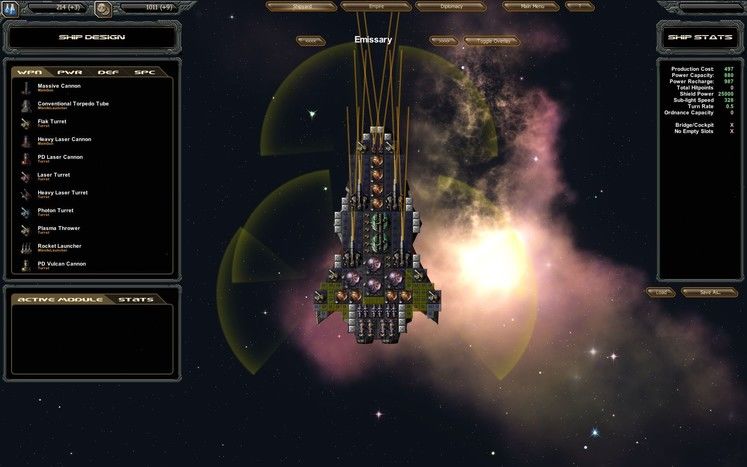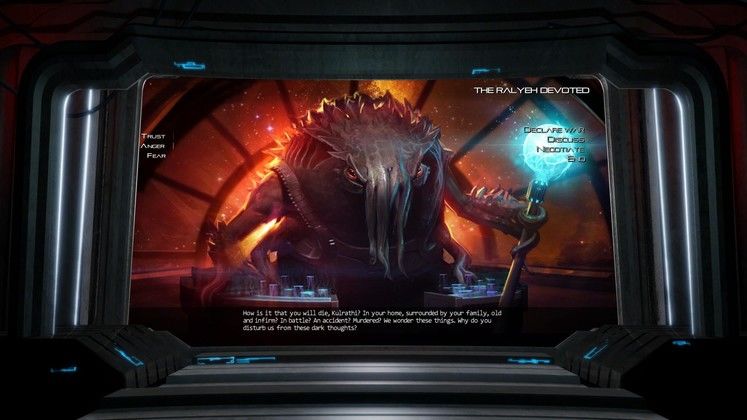There’s no real narrative or thread to pull you through StarDrive, you simply choose which of the eight races you want to play as, and then you can either go with their ‘stock’ traits and bonuses (reminiscent of Endless Space), or customize your own. The only real difference each race has is the way their ships look (which can affect the design – different shapes mean different configurations). Some traits, like being a Cybernetic Race, also influence play style. It’s a shame, because whilst other 4X (space or otherwise) games also don’t really have narratives to go by, they do a better of job giving you tools that help you create an internal narrative, or at least spark your imagination – something this title unfortunately lacks.
 |
| Ship design can be incredibly rewarding, but more feedback is needed to allow for genuine experimentation from the standard load-outs. |
The game is labelled as ‘action 4x’, although to be honest it has more in common with RTS titles than anything else. Everyone starts out equal, with the one colonised planet, and the first thing you need to do is find another planet to colonise quickly. Depending on how you set-up your game, you’ll meet some of the other races before too long. Some you’ll get along with, others you won’t, and surprisingly you don’t actually have to do anything for these opinions to form; some of the more aggressive species will attack you just for having a smaller fleet then they do.
The design of the game world is meant to be challenging. Managing your growing interstellar empire becomes a greater and greater economical and logistical challenge, as systems with habitable planets are typically a bit of a commodity (they’re not that common). Each planet has three values associated with it: Food, Production and Research. Food is obviously needed to grow the population, but for every .1 pop, the food generation decreases, and it is entirely possible for a planet’s max population to actually exceed what the planet can actually grow for itself.
Planets can stockpile excess food and production, which can then be stored or exported, so using the above example you’d need to find another world that has excess food and set up regular trade routes. Despite this game supposed to being more about combat and ship design, you’ll spend most of your time keeping your economy going – especially when your empire grows beyond a certain size. The automation tools on the management side aren’t that great, so you’ll be whizzing around your planets a lot making sure everything is in order.
Each planet has a ground ‘grid’, which is made up of habitable and inhabitable areas. Depending on the type and size of the planet, the ‘poor vs. rich’ modifier will determine how many squares on the grid are free to be occupied by troops or buildings. Tech research allows you to build biospheres that increase population and open up a previously closed square. To be honest, given the challenges of colonising really inhospitable planets, you’re unlikely to encounter space management problems in the beginning – that’s more of a late game thing.
 |
| Empires can grow to sizable length. The logistics regarding defence and economy expand with them. |
Researching new techs is a deliberately paced process, and technologies are spread across several areas; from forming weapons and energy management, to economy, to ship design and more. This is meant to give you some flexibility as to where you focus your civilization, but considering how easy you can find yourself at war, keeping up with military techs is a must.
StarDrive is a bit of a weird one, in a way – as we mentioned above, it claims to be more ‘action’ focused, and highlights the combat and the ship design, and yet these two areas could be considered the weaker portions of the game. It contains many examples of counter-intuitive design that are just plain odd. Take ship design, to start with: every ship class has a certain amount of square slots they need filling,like Tetris, except you’re supposed to fill out the entire space. Some components use more square slots than others, and every square slot belong to a lettered group (some to several), and certain modules can only be put on certain square groups. It’s great in the sense that you’re essentially given a blank canvas to fill, but there isn’t as much feedback as there should be.
For example, the ramifications of where you put your weapons (as they can go in the ‘middle’ of the canvas, as well as the edges) and other components aren’t really explained that well. Plus the actual performance of your ship is hard to decipher. All you get when designing your ship is a small list of stats to the side. Obviously, green means good and in most cases the higher the better (apart from things like mass), but you have no idea what that really means until you build one and get it out there.
 |
| I honestly love the artwork, and you can’t really go wrong with Space Bears. Shame there’s not more individuality amongst the races. |
Considering how expensive even Frigate-class ships can be, that’s potentially a lot of wasted resources and time. Through a system of trial and error, we’ve realised that ships take damage starting from the edges of the ‘grid’, and generally working their way in. As square slots take damage, whatever’s on them also gets damage, so things like hull plating should really go on the outside. You also eventually get a sense of what values translate into what general kind of performance, but there still could be a lot more feedback than there is.
Once you’ve gotten the hang of designing ships though, you’ll want to use them in combat. Unfortunately the game falls down a bit here as well. The fleet AI, for example, doesn’t really work properly in terms of grouping and maintaining formation. This is a shame, because StarDrive provides an entire fleet interface that allows you to set order to individual elements within the fleet, essentially allowing you to do all of the micro-managing before you even get into the fight.
Aspects such as location within the formation and operational range can be customised on a fleet-by-fleet basis, and yet the AI can’t handle something as simple as making sure all of the ships travel in formation. You end up with the faster ships always getting their first, getting blown up, and the bigger slower ships arriving without any back up. Even opting to micro-manage in real-time doesn’t really work that well either. All you really end up doing is filling your fleets with as many ships as possible, and then throwing them at the enemy and praying for the best.
 |
| What a wonderful nose you have... |
This is a point I make with a lot of games, but it’s still a valid one, I feel: StarDrive is not a ‘bad’ game. It’s not particularly great either, but it’s certainly nowhere near as terrible as SOTS2 or Legends of Pegasus were. The trickiest thing with StarDrive, is trying to determine where the game’s potential lies. Some things probably can’t just be ‘patched’ out, although there are some automation bugs that we hope will be sorted soon. Mainly, the ship design feedback needs to be improved, and if the fleet and combat AI could get a fix as well, that would be great.
Also, making the galaxy feel more alive wouldn’t hurt either. It’s all a bit soulless right now, even the other races have limited interactions available. I’d hesitate to spend the full £24.99 on this game – not right now anyway. Wait for a better discount, or wait until they’ve made some improvements to it. As it stands, there are bigger and better titles to be excited about.
STARDRIVE VERDICT
Also, making the galaxy feel more alive wouldn’t hurt either. It’s all a bit soulless right now, even the other races have limited interactions available. I’d hesitate to spend the full £24.99 on this game – not right now anyway. Wait for a better discount, or wait until they’ve made some improvements to it. As it stands, there are bigger and better titles to be excited about.
TOP GAME MOMENT
Designing your own custom ship and rolling it out for the first time can be pretty satisfying, until you realise you forgot to give it enough power generators. Oops.




